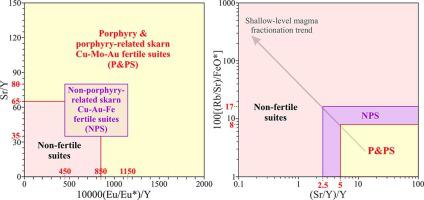Ore Geology Reviews ( IF 3.3 ) Pub Date : 2022-09-20 , DOI: 10.1016/j.oregeorev.2022.105108 Tatyana V. Svetlitskaya , Peter A. Nevolko

|
Identifying new whole-rock geochemical fertility indicators for porphyry and skarn productive systems is a geological challenge due to a large variety of tectonic settings, magmatic source regions and petrological evolution of the parental intrusions. This is especially true for non-porphyry-related Cu-Au-Fe skarns for which no relevant whole rock or chemical mineral indicators are currently recorded. Our study provides high‐precision whole‐rock data of granitoids from the Kultuma Cu-Au-Fe skarn deposit in Eastern Transbaikalia, Russia, in order to define productive skarn suites.
The Kultuma Cu-Au-Fe skarn deposit consists of two contemporaneous (dated at ca. 159–161 Ma and 157–158 Ma using U-Pb methods) pulses of mineralized high-calc-alkaline to shoshonitic I-type granites that were emplaced during the final stage of collision following the closure of the Mongol–Okhotsk ocean. Igneous suites of both skarn-related pulses are high-K (3–5 wt% K2O) and range in composition from low-silica and high-magnesian monzonite porphyries to high-silica and high- to moderate-magnesian quartz‐syenite and granite porphyries. They originated from moderately oxidized (zircon Eu/Eu* = avg. 0.24 and ΔFMQ = avg. + 0.4 to + 0.6), moderately hydrous (whole-rock Sr/Y = 40–64; zircon Yb/Dy = avg. 3.6), low to moderately fractionated (whole-rock Eu/Eu* = avg. 0.86) magmas that evolved through substantial interaction with the lower crust (whole-rock La/Yb = 24–54, (Dy/Yb)CN = 1.4–2.0, Yb = 0.5–1.2 ppm) followed by deep-level amphibole and shallow-level plagioclase fractionation, respectively.
Based on a comprehensive set of new whole‐rock data, we propose the use of (Sr/Y)/Y and 100[(Rb/Sr)/FeO*] ratios to discriminate between fertile non-porphyry-related skarn and porphyry and porphyry-related skarn suites and unmineralized granite intrusions. Our proposed new discrimination thresholds of (Sr/Y)/Y and 100[(Rb/Sr)/FeO*] are effective in Eastern Transbaikalia, but they could potentially be useful for the geochemical discrimination between intrusions prospective for Cu-Mo-Au-Fe skarn and porphyry mineralization and barren calc‐alkaline granitic suites in other arc‐related mineral belts worldwide.
中文翻译:

新的全岩矽卡岩和斑岩肥力指标:来自俄罗斯东外贝加利亚铜-金-铁矽卡岩和铜-钼-金斑岩矿床的见解
由于各种构造环境、岩浆源区和母体侵入体的岩石演化,为斑岩和矽卡岩生产系统确定新的全岩地球化学肥力指标是一项地质挑战。对于非斑岩相关的 Cu-Au-Fe 矽卡岩来说尤其如此,目前没有记录相关的全岩或化学矿物指标。我们的研究提供了来自俄罗斯东外贝加利亚库尔图马铜金铁矽卡岩矿床的花岗岩高精度全岩数据,以确定生产性矽卡岩组。
Kultuma Cu-Au-Fe 矽卡岩矿床由两个同时期(使用 U-Pb 方法测年在159-161 Ma 和 157-158 Ma)脉冲矿化的高钙碱性到磷灰质 I 型花岗岩组成。在蒙古-鄂霍次克洋关闭后碰撞的最后阶段。两种矽卡岩相关脉冲的火成岩组都是高 K(3-5 wt% K 2 O),成分范围从低硅和高镁二长斑岩到高硅和高到中镁石英正长岩和花岗斑岩。它们起源于中度氧化(锆石 Eu/Eu* = avg. 0.24 和 ΔFMQ = avg. + 0.4 至 + 0.6),中度含水(全岩 Sr/Y = 40–64;锆石 Yb/Dy = avg.3.6),低到中度分馏(全岩 Eu/Eu* =平均0.86)岩浆通过与下地壳的大量相互作用而演化(全岩 La/Yb = 24-54,(Dy/Yb)CN = 1.4 –2.0,Yb = 0.5–1.2 ppm),然后分别是深层闪石和浅层斜长石分馏。
基于一组全面的新全岩数据,我们建议使用 (Sr/Y)/Y 和 100[(Rb/Sr)/FeO*] 比率来区分肥沃的非斑岩相关矽卡岩和斑岩,以及斑岩相关的矽卡岩组和未矿化的花岗岩侵入体。我们提出的 (Sr/Y)/Y 和 100[(Rb/Sr)/FeO*] 的新判别阈值在东外贝加尔地区有效,但它们可能对潜在的 Cu-Mo-Au 侵入体之间的地球化学判别有用-全球其他与电弧相关的矿带中的铁矽卡岩和斑岩矿化以及贫瘠的钙碱性花岗岩套。



























 京公网安备 11010802027423号
京公网安备 11010802027423号